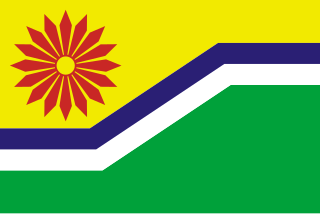
Dalbergia is a large genus of small to medium-size trees, shrubs and lianas in the pea family, Fabaceae, subfamily Faboideae. It was recently assigned to the informal monophyletic Dalbergia clade : the Dalbergieae. The genus has a wide distribution, native to the tropical regions of Central and South America, Africa, Madagascar and southern Asia.

The Eastern Highlands, also known as the Manica Highlands, is a mountain range on the border of Zimbabwe and Mozambique. The Eastern Highlands extend north and south for about 300 kilometres (190 mi) through Zimbabwe's Manicaland Province and Mozambique's Manica Province.

Brachystegia is a genus of tree of the subfamily Detarioideae that is native to tropical Africa.

Plectranthus is a genus of about 85 species of flowering plants from the sage family, Lamiaceae, found mostly in southern and tropical Africa and Madagascar. Common names include spur-flower. Plectranthus species are herbaceous perennial plants, rarely annuals or soft-wooded shrubs, sometimes succulent; sometimes with a tuberous base.
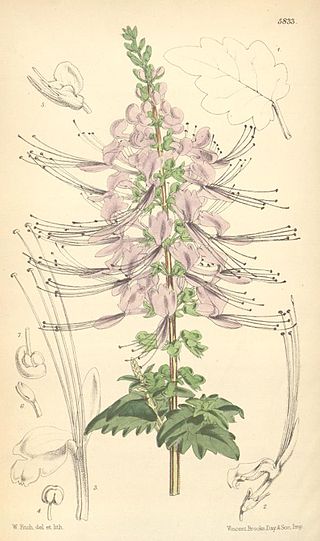
Orthosiphon is a genus of plants in the family Lamiaceae native to Africa, Southern Asia and Queensland, with one species (O. americanus) in Colombia. They are herbaceous shrubs which grow to a height of 1.5 m (5 ft). Some Orthosiphon species are popular garden plants because of their flowers, which are white and bluish with filaments resembling a cat's whiskers. In the wild, the plants can be seen growing in forests and along roadsides.

Craibia is a genus of flowering plants in the family Fabaceae. It contains nine species native to sub-Saharan Africa, ranging from Liberia east to the Horn of Africa and south to the Cape Provinces of South Africa.
Xylia mendoncae is a species of flowering plant in the family Fabaceae. It is found only in Mozambique.

Entada is a genus of flowering plants in the family Fabaceae, in the mimosoid clade of the subfamily Caesalpinioideae. It consists of some 30 species of trees, shrubs and tropical lianas. About 21 species are known from Africa, six from Asia, two from the American tropics and one with a pantropical distribution. They have compound leaves and produce exceptionally large seedpods of up to 1.5 metres (4.9 ft) long. Their seeds are buoyant and survive lengthy journeys via rivers and ocean currents, to eventually wash up on tropical beaches.

Aeschynomene is a genus of flowering plants in the family Fabaceae, and was recently assigned to the informal monophyletic Dalbergia clade of the Dalbergieae. They are known commonly as jointvetches. They range across tropical and subtropical regions of the Americas, sub-Saharan Africa, south, southeast, and east Asia, and Australia. These legumes are most common in warm regions and many species are aquatic.

The Southern Zanzibar–Inhambane coastal forest mosaic, also known as the Southern Swahili coastal forests and woodlands, is a tropical moist broadleaf forest ecoregion of eastern Africa. It is a southern variation of Northern Zanzibar-Inhambane coastal forest mosaic. The ecoregion supports habitats of forest, savanna and swamps. The southern portion of the ecoregion is not as well studied due to the 1977-1992 civil war in Mozambique.
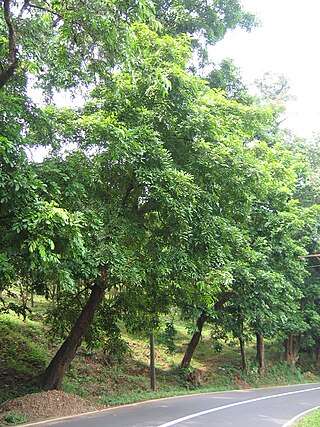
Xylia xylocarpa is a species of tree in the mimosoid clade of the subfamily Caesalpinioideae of the family Fabaceae.

Argyrolobium is a genus of flowering plants in the family Fabaceae. It belongs to the subfamily Faboideae. Members of this genus are found in Africa, western and south Asia, and southern Europe.
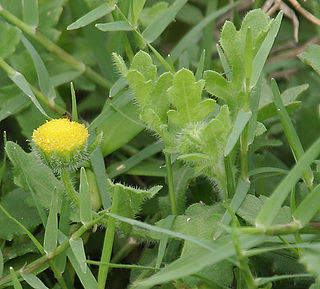
Grangea is a genus of flowering plants in the family Asteraceae.
Gyrodoma is a genus of African flowering plants in the family Asteraceae.

Newtonia hildebrandtii, the Lebombo wattle, is a medium-sized tree native to eastern Africa. It is a protected tree in South Africa.

Pycnostachys is a genus of plants in the family Lamiaceae, first described in 1826. It is native to sub-Saharan Africa including Madagascar.
- Pycnostachys abyssinicaFresen. - Ethiopia
- Pycnostachys angolensisG.Taylor - Angola
- Pycnostachys batesiiBaker - Cameroon, Zaïre, Sudan, Uganda
- Pycnostachys chevalieriBriq. - Central African Republic
- Pycnostachys ciliataBramley - Tanzania, Malawi, Mozambique, Zambia
- Pycnostachys coeruleaHook. - East Africa from Ethiopia to Botswana; Madagascar
- Pycnostachys congensisGürke - Zaïre, Zambia
- Pycnostachys de-wildemanianaRobyns & Lebrun - East Africa from Burundi to Zimbabwe
- Pycnostachys deflexifoliaBaker - Kenya, Tanzania, Uganda
- Pycnostachys descampsiiBriq. - Zaïre
- Pycnostachys elliotiiS.Moore - Zaïre, Uganda
- Pycnostachys eminiiGürke - from Cameroon to Ethiopia + Tanzania
- Pycnostachys erici-roseniiR.E.Fr - Zaïre, Uganda, Burundi, Rwanda
- Pycnostachys goetzeniiGürke - Zaïre, Uganda, Rwanda
- Pycnostachys gracilisR.D.Good - Angola
- Pycnostachys graminifoliaPerkins - Tanzania
- Pycnostachys kassneriDe Wild - Zaïre, Zambia, Tanzania
- Pycnostachys lancifoliaBramley - Tanzania
- Pycnostachys meyeriGürke - western + central Africa
- Pycnostachys nepetifoliaBaker - Kenya
- Pycnostachys niamniamensisGürke - South Sudan, Kenya, Uganda
- Pycnostachys orthodontaGürke - Zimbabwe, Mozambique, Zambia, Tanzania
- Pycnostachys parvifoliaBaker - Zambia, Tanzania, Malawi
- Pycnostachys prittwitziiPerkins - Zambia, Tanzania
- Pycnostachys pseudospeciosaBuscal. & Muschl. - Zaïre, Zambia
- Pycnostachys recurvataRyding - Ethiopia
- Pycnostachys reticulata(E.Mey.) Benth. - central + southern Africa
- Pycnostachys ruandensisDe Wild. - east-central Africa
- Pycnostachys schliebeniiMildbr. - east-central Africa
- Pycnostachys schweinfurthiiBriq - western + central Africa
- Pycnostachys speciosaGürke - Kenya, Uganda, Tanzania, Rwanda
- Pycnostachys sphaerocephalaBaker - Zambia, Tanzania, Malawi, Zaïre
- Pycnostachys stuhlmanniiGürke - central Africa
- Pycnostachys umbrosa(Vatke) Perkins - Kenya, Tanzania
- Pycnostachys urticifoliaHook. - southeastern Africa
- Pycnostachys verticillataBaker - Zambia, Tanzania
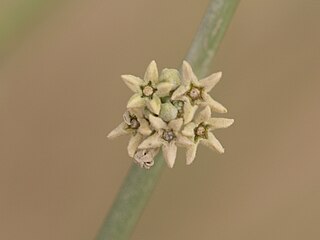
Leptadenia is a genus of plants in the family Apocynaceae, first described as a genus in 1810. It is native to Africa, including Madagascar, as well as southwest Asia and the Indian Subcontinent.
- Leptadenia arborea(Forssk.) Schweinf. - Sudan, Ethiopia
- Leptadenia lancifolia(Schumach. & Thonn.) Decne. - tropical Africa
- Leptadenia madagascariensisDecne. - Madagascar
- Leptadenia pyrotechnica(Forssk.) Decne. - widespread from Algeria to India
- Leptadenia reticulata(Retz.) Wight & Arn. - Madagascar

Ipomoea oenotherae is a species of plant of the morning glory genus, Ipomoea, in the family Convolvulaceae. It derives its name from the resemblance it bears to plants in the genus Oenothera. Ipomoea oenotherae is a succulent and a cryptophyte.
Cornus volkensii is a species of tree in the family Cornaceae native to montane forests of eastern Africa, from South Sudan and Kenya south to Zimbabwe and Mozambique.

